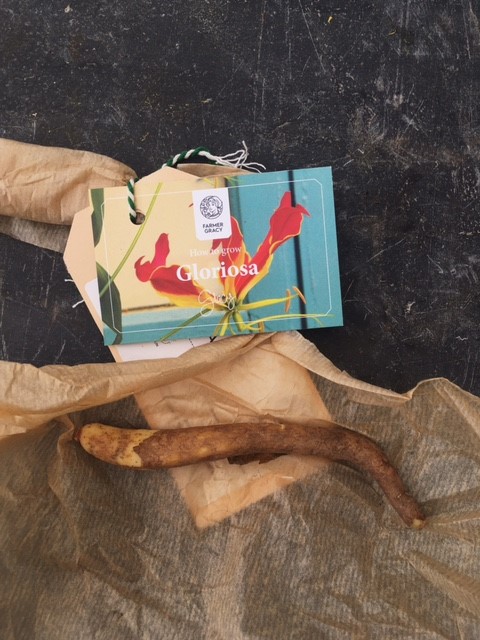
I have an exciting new plant for the greenhouse, which I am going to start on starting into growth this week. Gloriosas are beautiful colourful climbing plants, and sometimes known as climbing lilies, though really their flowers are not particularly lily-like. They have extraordinary twisted petals in red and orange and are the national flower of Zimbabwe. Given enough warmth the stems will twine up a trellis and I have a fence all the way around by veranda. I fancy growing mine here this summer, twining up the supports, and blooming exotically among the pelargoniums, the lilies and the houseplants outside for their summer holiday.
I’ve always admired them but never had a go myself, and now is the time to get them started – unfortunately they aren’t the easiest of plants, but I suppose a little diva-dom can be forgiven for a beautiful display. They want as much heat as possible while they are growing, and are utterly frost tender, and so I am starting them in a heated propagator in the greenhouse. They are supplied as lengths of tuber and should be planted in pots 2-3 inches below the surface of the soil, and watered well. They will then stay in the propagator nice and cosy until they peep their heads above the soil, and then perhaps for a little longer still. It is really important to keep them warm and growing strongly, so I am thinking I might set up a root mat to give them some bottom heat and just keep them growing well: spring being as unpredictable as it is I will need to try to ensure that they have a constant source of dependable heat, or they will sulk and refuse to grow, or worse may even get frosted and die. Incidentally they are a brilliant plant for a heated conservatory, which suits their need for warmth and in which they will flower long through summer, but not having one of those I will have to try to provide them with the best approximation I can.
Once all chance of frost has passes – here that means around early May – they can be planted out into pots and placed onto the veranda, though perhaps with a bit of fleece handy to throw over them at night during cooler spells. I will train mine upwards and along and hope for lots of blooms, feeding them with a liquid fertiliser as often as I can remember.
In late summer there will be fewer and fewer flowers produced and this is the sign to cut back on watering to encourage them to die back to their tubers. The green parts of the plant will start to wither and die back, and once they have done that you can trim them off and dig them up. If they are hit by a light frost before this it will blacken the stems and this is the sign to lift them and get them ready for storage. Dig up very carefully and look to see if your tuber has produced a daughter tuber, in which case you should carefully snip them apart. Gloriosa lilies need at least a 6-8 rest period, which wont be hard in our long winters. They mustn’t dry out during this time, so put them into a little compost in a plastic bag, mist slightly and seal, perhaps checking every now and then in case they have dried out or moulds have set in. Keep them somewhere cool and frost free – that tricky balance to find, but perhaps a shed near to the house or a porch – and bring them out next year to start all over again.


